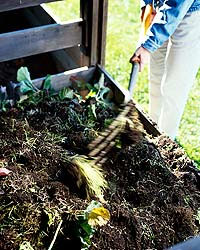
Good compost is made up of five components: carbon materials, nitrogen materials, air, water, and beneficial microbes.
Composting is the natural process whereby organic matter breaks down into a state that improves soil texture and moisture retention while feeding the soil microorganisms essential to plant growth and health. Northern New Mexico soils are often low in organic matter so adding compost to garden, flower beds, trees, etc. several times a year can make a big difference.
What To Compost
Good compost is made up of five components: carbon materials, nitrogen materials, air, water, and beneficial microbes.
Carbon Materials: Carbon materials are dry and fibrous. They are slower to decompose than other compost additives, but their fibers help aerate the pile and improve the texture of the final product. Carbon materials can include:
• shredded paper egg cartons
• shredded non-glossy paper
• shredded black and white newspapers (NOT the glossy color sections—the dyes can be poisonous)
• crushed eggshells
• branches from pruning shrubs and trees
• dry leaves
• hay or straw
• wood shavings and sawdust from untreated lumber
• human or pet hair
• crushed corncobs
• tea bags (remove staples and tags)
Nitrogen Materials: Nitrogen materials are wetter and greener than carbon materials and they are essential to the decomposition process. Nitrogen materials can include:
• fruit and vegetable scraps (except citrus)
• fresh clippings from grass that has not been treated with herbicides
• chopped up weeds that have not yet formed seeds
• chopped up vegetable plants (don’t use them if they died from disease)
• coffee grounds
• discarded flower bulbs and houseplants
Never add these ingredients to a compost bin:
• citrus peels or fruit (such as oranges, grapefruits, lemons, limes)
• animal scraps (bones, meat, skin, fat) because they attract pests and smell bad
• human, dog, or cat feces (it can harbor diseases transmittable to humans)
• colored or glossy paper and newspaper — the inks can be toxic in the environment (soy inks are okay)
• artificial fibers, such as nylon (they won’t decompose)
• wood ash, coal ash, or charcoal ash (they can raise the pH of the pile and may contain toxic substances)
• pine or piñon needles (they contain natural chemicals that can inhibit plant growth)
• untreated sewage (contains unwanted ingredients)
• clippings from herbicide-killed plants

Turn the pile at least once a month to let in air. Turning speeds up the composting process, but even if it’s never turned, a properly made heap will rot down in six months to a year.
How To Build A New Compost Pile
1. How to build? Use commercial compost bins or make one from wood, discarded pallets, wire mesh, cinder blocks, or straw bales.
2. How large? For optimum results, at least 27 cubic feet which creates an interior space 3 feet wide by 3 feet deep by 3 feet tall. A pile of at least 64 cubic feet in area (4′ x 4′ x 4′) could do even better, particular during the winter and early spring, because its volume is great enough to protect its living warm interior from encroaching frost.
3. Where to place? Composting should be done in full sun or a minimum of six hours of direct sun per day.
4. Adding materials: As they become available, add in layers the carbon and nitrogen materials (see above). To speed up the decomposition process sprinkle over each layer 2 tablespoons (no more) of a high-nitrogen fertilizer or a half cup of any of the following:
dry powdered bloodmeal,
dry powdered horse-, poultry-, or llama-manure,
Gro-Power™ fertilizer or commercial compost “starter.”
Worm castings usually contain worm eggs that hatch in the compost to enrich and aerate it. Live earthworms are good to compost, night crawlers are not.
5. Adding water Before placing each layer of compost lightly water it. Make it moist, not soggy — like the moistness of a wrung-out sponge. it’s too wet If, when you push down on the compost water leaks, . Check the pile every five to seven days to determine if it is drying out or getting too wet.
6. Turning Turn the pile at least once a month to let in air. Turning speeds up the composting process, but even if it’s never turned, a properly managed compost will eventually decompose.
7. When will it be ready to use? As it matures, it will shrink. Finished compost is dark brown to black, with a crumbly texture.
8. How to use? Add the compost to enrich potting soils for use with container growing indoors or out. It can be added directly to both new and existing outdoor garden beds. Spread it over outdoor beds at a depth of two to three inches.
When using compost as mulch for trees, shrubs, or other plants, be sure to leave a three-to-four inch gap around the plant’s trunk or stem. This is because the above-ground parts of the plant cannot be constantly moisture or fungal disease may develop.
